Battery-operated hidden childcare cameras offer discreet, comprehensive security for homes and businesses, with real-time video streaming and motion detection via smartphones. However, they require regular battery maintenance, face signal interference risks, and necessitate strong encryption to protect privacy and data from unauthorized access. To maximize effectiveness, strategically place multiple cameras for unobstructed views, covering all areas of the childcare space while preserving privacy through responsible network security practices.
Wireless surveillance equipment, particularly battery-operated hidden childcare cameras, offers unprecedented safety and peace of mind in sensitive environments. However, navigating their location detection presents unique challenges. This article delves into the intricacies of understanding these devices, focusing on strategies to locate battery-operated hidden cameras in childcare settings effectively. We explore optimal placement techniques while maintaining privacy standards, ensuring a safe yet secure environment for children.
- Understanding Wireless Surveillance Equipment: Benefits and Challenges
- Locating Battery-Operated Hidden Cameras in Childcare Settings
- Effective Placement Strategies for Optimal Detection
- Maintaining Privacy While Ensuring Safety with Wireless Technology
Understanding Wireless Surveillance Equipment: Benefits and Challenges
Wireless surveillance equipment, such as battery-operated hidden childcare cameras, offers numerous benefits for home and business security. Their wireless nature eliminates the need for unsightly cables, making them ideal for discreet monitoring. These devices can be easily placed in various locations, providing a comprehensive view of areas that may be difficult to access or cover with traditional wired cameras. With real-time video streaming and remote access via smartphones, users can monitor activities from virtually anywhere, enhancing peace of mind.
However, wireless surveillance systems also present challenges. Battery-operated cameras require regular maintenance and replacement to ensure continuous operation. Signal interference from nearby devices or structural obstacles can disrupt the camera’s connectivity, leading to potential downtime. Additionally, ensuring privacy and data security is paramount, as these devices transmit sensitive information over wireless networks. Users must implement robust encryption methods and follow best practices for secure network management to protect against unauthorized access.
Locating Battery-Operated Hidden Cameras in Childcare Settings
Effective Placement Strategies for Optimal Detection
To achieve optimal detection with wireless surveillance equipment, strategic placement is key. One effective strategy for parents considering Battery Operated Hidden Childcare Cameras is to install them in areas that offer unobstructed lines of sight while remaining out of direct view. This could mean placing cameras near windows or open doorways, but ensuring they’re not easily visible from outside. The goal is to create a network of hidden observers without compromising privacy.
Additionally, consider the layout and flow of the space being monitored. Positioning cameras in corners or along walls can provide comprehensive coverage, capturing both horizontal and vertical movements. By utilizing multiple camera locations, you can effectively navigate around obstacles like furniture or décor, ensuring no blind spots exist. This multi-pronged approach maximizes detection capabilities, giving parents peace of mind.
Maintaining Privacy While Ensuring Safety with Wireless Technology
Maintaining privacy and ensuring safety can sometimes seem like a challenging dilemma, especially with the rise of wireless technology in our daily lives. Battery-operated hidden childcare cameras, for instance, offer parents peace of mind by allowing them to remotely monitor their children’s activities while they are away. However, it’s crucial to employ these tools responsibly.
To protect privacy, users should take precautions like securing network connections with strong passwords and encryptions. Additionally, keeping the number of connected devices to a minimum and regularly updating firmware can prevent unauthorized access. By balancing safety measures with privacy concerns, individuals can leverage wireless surveillance equipment like hidden childcare cameras without compromising their personal space and confidentiality.
Wireless surveillance equipment, particularly battery-operated hidden cameras in childcare settings, offer enhanced safety measures but require strategic placement for optimal detection. By understanding the benefits and challenges of these devices, implementing effective location detection tips, and prioritizing privacy while ensuring safety, caregivers can create a secure environment without compromising on child well-being. This approach ensures that battery-operated hidden childcare cameras serve their purpose while adhering to essential privacy considerations.
